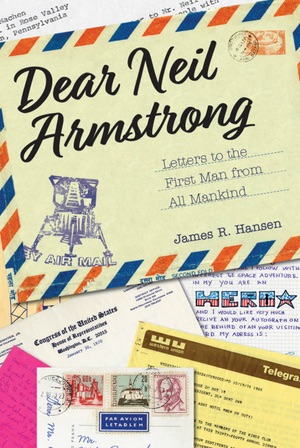Review: Dear Neil Armstrongby Jeff Foust
|
| A 13-year-old boy wrote to Armstrong complaining that “Star Trek” was being taken off the air, “and I thought you could write the network a letter. I’m sure they would listen to you.” |
A sample of that correspondence is available for all to read in the book Dear Neil Armstrong. James Hansen, the historian who wrote the well-regarded biography of Armstrong, First Man, in 2005 (see “Review: two views of the first man”, The Space Review, July 17, 2006), gained access to Armstrong’s letters, now archived at Purdue University. “I always regarded my biography of Neil—as lengthy as it was, over 700 pages—as incomplete, and in some respects not very well informed,” Hansen writes in this book, because he had access to only a small fraction of those letters that Armstrong was willing to share at the time.
The archive of Armstrong’s papers at Purdue includes approximately 70,000 pieces of fan mail, which Hansen writes he “became especially fascinated with” and led to this book, a sampling of those letters. The correspondents range from business and political leaders to children to ordinary people around the world who wanted to congratulate Armstrong or who sought an autograph, advice, information, or something more.
The letters start before the mission itself, with people offering advice on what Armstrong should say or do when he set foot on the Moon, although the bulk are from the post-Apollo 11 time. One chapter is devoted to correspondence from around the world (a separate one is focused on letters from the Soviet bloc) and another from those in the US. Many simply sought an autograph, or answers to questions, or just to offer well wishes to him. One particularly heartwrenching one was from a 14-year-old boy asked for an autograph and personal note—a letter accompanied by one from his mother, who said he had a “terminal malignancy.” Armstrong did send that autographed picture and note, and got a thank-you letter from the boy’s mother, who said he received it just before he passed away.
Others, though, sought assistance, support, or participation in business opportunities. Some were relatively innocuous: a 13-year-old boy wrote to Armstrong complaining that “Star Trek” was being taken off the air, “and I thought you could write the network a letter. I’m sure they would listen to you.” Others were, well, strange: the president of Naked City (“America’s largest nudist resort”) asked if Armstrong would judge their Miss Nude World Contest.
The book highlights the demands on his time sought by many people, who in some cases would be angered if they didn’t get an immediate, and positive, response. “I can’t help wondering if the reason that I haven’t had any response from him is because he is not able to read or write,” one person wrote when she did not get a response an initial letter asking about the benefits of the space program. (She did get a response, from Armstrong’s assistant, to the second letter.)
| Armstrong, Hansen writes, was “a person very tightly in control at all times of what he should do” based on his sense of character. That approach, Hansen argues, “seems clearly to have constrained him from accepting different—potentially healthy—things in his life.” |
From the correspondence included in the book, Armstrong turned down nearly all the opportunities for business deals, books, and political activities that came his way. That included entreaties to participate in Republican and Democratic party politics, such as one from fellow Apollo astronaut Harrison Schmitt seeking Armstrong’s endorsement for Schmitt’s 1976 campaign for the US Senate in New Mexico. Armstrong replied that he would be “overjoyed” to see Schmitt win—he did, but lost his reelection bid in 1982—but that he “maintained a policy of non-involvement in public politics and intend to continue that policy.”
Armstrong, Hansen writes in one chapter, was “a person very tightly in control at all times of what he should do” based on his sense of character. That approach, Hansen argues, “seems clearly to have constrained him from accepting different—potentially healthy—things in his life that his family, his friends, his fellow pilots and astronauts, his business associates, and his many thousands of regular fans and onlookers felt would in fact have been appropriate and generous acts on Neil’s part, things he could have done that actually would have made his life easier.” That approach, Hansen says, was a major factor in his divorce from his first wife, Janet.
The letters included in Dear Neil Armstrong, along with responses from Armstrong and his assistants (who are profiled in the book’s appendix) and commentary from Hansen, offer an enlightening look at Armstrong and his interactions with the public. This book is only a tiny sampling of the letters and other papers that fill hundreds of archival boxes at Purdue. Hansen writes he is planning at least one more book that will examine letters on specific issues, from religion to conspiracy theories to his experiences in the corporate world. There is still much more to learn about Armstrong.
Note: we are temporarily moderating all comments submitted to deal with a surge in spam.
